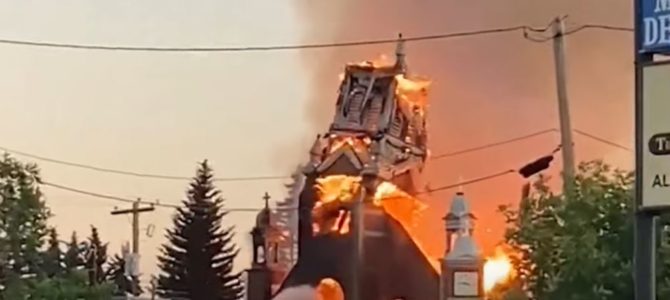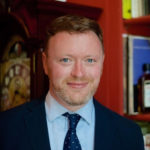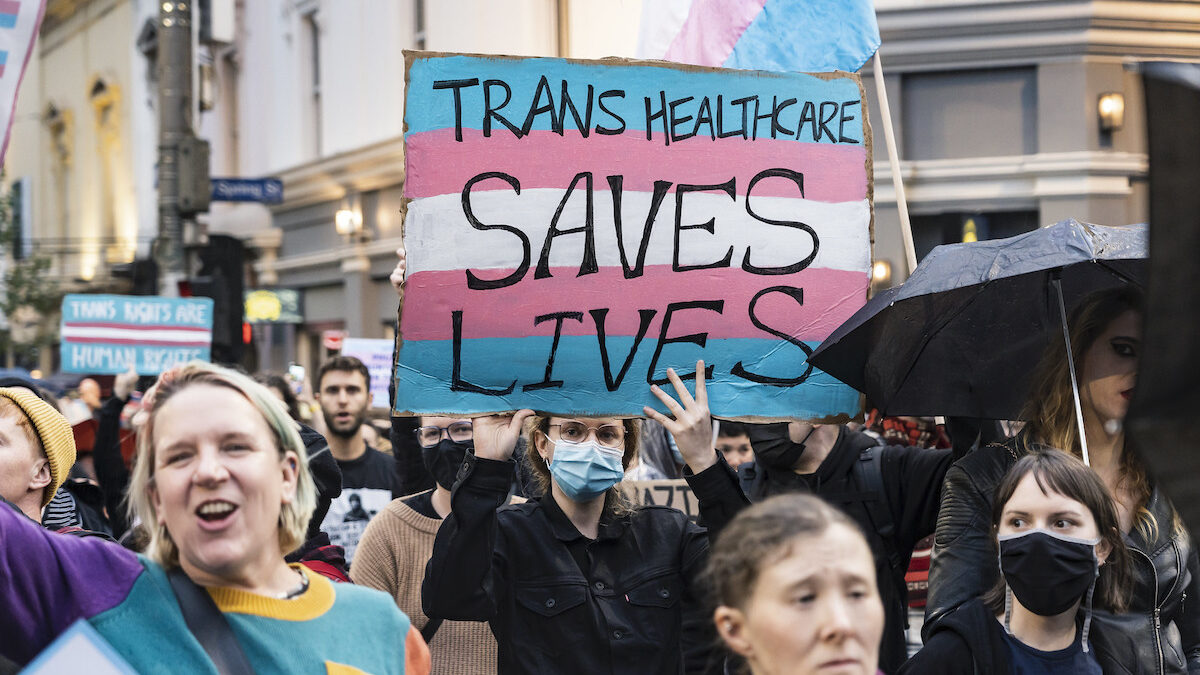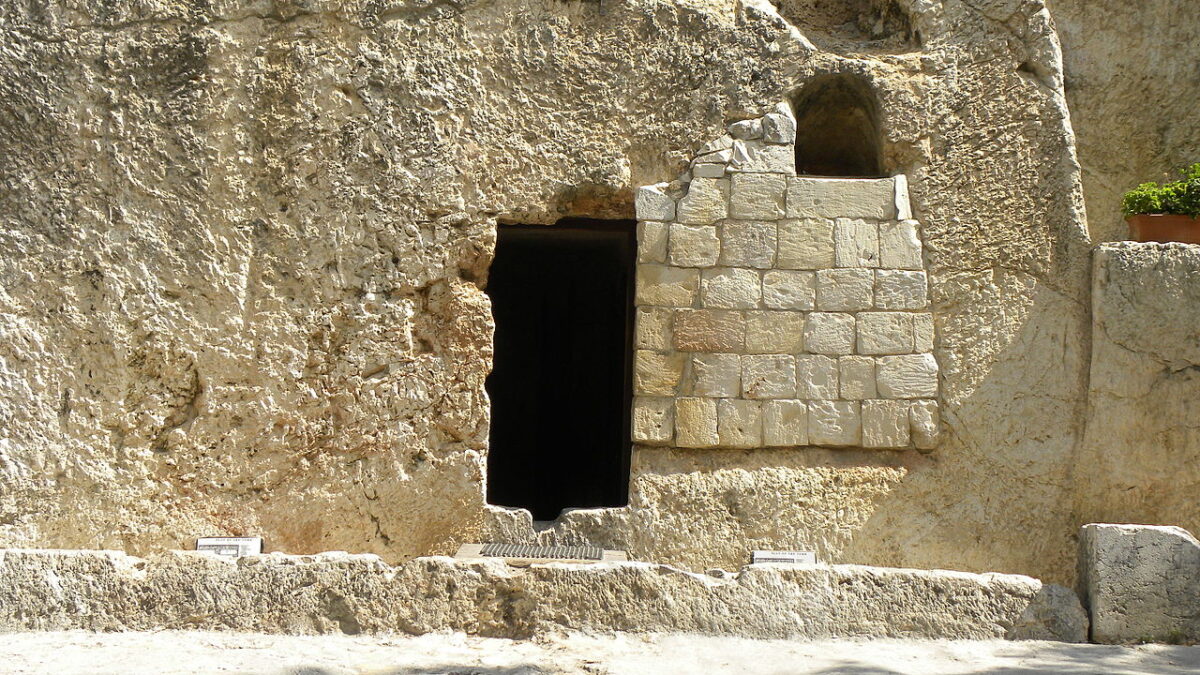
St. Ann’s Catholic Church was a small church built to serve a small town, but that humble building was a mighty testament to the people who built and nourished it.
The people of Chuchuwayha Indian Reserve Number Two traveled more than 40 miles, each way, by horse and wagon, to pick up the lumber they used to build their small church, by hand, outside the town of Hedley, British Columbia. That church stood for more than a century, providing spiritual nourishment to its small congregation at the far-flung edge of the world.
But now, St. Ann’s is gone. On June 26, it burned until nothing was left but a smoldering pile of ash. It wasn’t lightning or a tragic accident. It was arson — and it wasn’t an isolated incident.
All over Canada, churches are going up in flames. On the same day 25 miles south, Our Lady of Lourdes parish was burned to the ground as well. The week before that, St. Gregory’s Church near Osoyoos was destroyed. So was Sacred Heart near Penticton.
All three were also more than a century old, historic, beautiful houses of worship, destroyed in a day out of hatred. Sacred Heart parishioners gathered to watch their doomed church burn. When the church bell finally fell to the ground with a single gong, some of them sobbed.
St. Jean Baptiste in Morinville, Alberta was burned to the ground. Another arson. At Holy Rosary church in Edmonton, a statue of St. John Paul II was vandalized with red paint.
All these are Catholic, but they aren’t the only ones being targeted. In Calgary, 10 churches of various denominations were vandalized in a single night. A few days later, a Vietnamese church was set on fire — just hours after it held its first full service in more than a year.
Overall more than two dozen churches in Canada have been targeted over the past few weeks — and people are cheering it on. Not just anonymous people, either: On June 30, Harsha Walia, the executive director of the British Columbia Civil Liberties Association, responded to a story of another church arson, saying “Burn it all down.”
Others rallied to her defense. Naomi Sayers, a lawyer and blue Twitter checkmark, said “I would help her burn it all down … and also, I would help anyone charged with arson if they actually did burn things.”
What’s going on? You might have heard a little bit about it. From the 1870s up through the 1990s, the Canadian government funded institutions called residential schools. We had similar institutions here in the United States. These were boarding schools created to educate American Indian children, and the explicit goal was to assimilate them to European ways.
Today, we can understand where these schools went astray. They took children away from their parents and communities. Without family to look out for them, some children were exposed to physical or sexual abuse. Thanks to insufficient government funding, schools were often overcrowded and students were underfed, making the schools unhealthy.
But an honest discussion of that tragedy is not what some people want: What they want to see is genocide, because then they can hate — and feel justified for doing so.
“Let’s call this for what it is,” Chief Jason Louie, a tribal chief of the Lower Kootenay Band, told the Canadian Broadcasting Channel. “It’s a mass murder of indigenous people. The Nazis were held accountable for their war crimes. I see no difference in locating the priests and nuns and the brothers who are responsible for this mass murder to be held accountable for their part in this attempt of genocide of an indigenous people.”
The vast majority of the priests, nuns, and ministers who built these schools and ran them for a century did so with noble and self-sacrificing intent. Now, they are smeared like they were running death camp experiments, and this ridiculous narrative has been deliberately egged on by the press and even the government.
“Officers are investigating vandalism at 10 churches,” the Calgary Police tweeted. “We must never forget residential schools are a part of our legacy that destroyed the lives of so many Indigenous families. But vandalism like this only creates further division, fear and destruction.”
If you’ve never heard the Ku Klux Klan’s heinous church-burning campaign described as “vandalism,” that’s because it would be heartless to do so. In Canada, it seems, neither honesty nor decency extends to Christians. And don’t forget — the Christians brought this on themselves.
While Alberta Premier Jason Kenney decried the arsons as “as attack on Canadian values” and “cowardly,” and pledged money to protect Christians, Prime Minister Justin Trudeau took a different tack.
“I can’t help but think,” Trudeau mused, “that burning down churches is actually depriving people who are in need of grieving and healing and mourning from places where they can grieve and reflect and look for support.”
“I can’t help but think,” he might well have said instead, “that burning down churches is bad. Sorry guys, the problem isn’t you — it’s me.”
Even as churches burn down around him, Trudeau is singling out not the arsonists, but Pope Francis. He’s demanding that the pope travel to Canada to deliver an apology for the residential school system.
It didn’t matter to Trudeau that it was a school system created not by the church, but by Canada’s government — and that he had promised to take care of the cemeteries five years ago. Nor did it matter that Pope Benedict XVI had hosted a delegation of First Nations Indians at the Vatican seven years before that, where he apologized for the church’s role in the government’s plan. Or that Canadian Prime Minister Stephen Harper had apologized 10 months before then, nor even that the Missionary Oblates of Mary Immaculate had beat them all to it by nearly 20 years.
But we’re in the midst of a full-blown moral frenzy. Even before reading long publicly available apologies and reports, an ounce of sense or credulity should have cast doubt on the sudden hysteria based on the notion that Catholic priests moved to the far-flung wilderness, fed, taught, clothed, and catechized Indian children, and then, for no reason, took the children aside and murdered them.
Consider, for instance, the “discovery” of 182 unmarked graves near St. Eugene’s Mission School outside Cranbrook. These unmarked graves aren’t hidden — they’re literally in a cemetery — and they’re not a mass grave, but individualized. They haven’t even found out if the graves contain children or adults; the cemetery was simply used by the entire community. The reason the graves are “unmarked” is that the wooden crosses used to mark them and the fence that kept them safe decayed. In other words, people have found that an old cemetery contained bodies.
It’s the same story at the Marieval Indian Residential School in Saskatchewan, where 751 graves were found. According to Chief Cadmus Delorme, these were all individual graves, they probably once had markers, and the cemetery almost certainly includes adults who lived in the area as well. But for those who would hate the church regardless, small-town cemeteries in impoverished rural areas are warped into mass graves.
All of this was carefully detailed in the Truth and Reconciliation Commission report released six years ago. So what’s the real story of the residential schools? No matter what, it’s not a fun one. Canadian government policy at the time was clear: The goal was to assimilate the First Nations into the rest of Canadian society. That meant training them in agriculture and Western trades. It meant dressing them in Western clothing and teaching them English.
When European settlers arrived in modern British Columbia, the tribes who lived there still practiced chattel slavery — something their woke champions might be surprised to learn. Sometimes, at their potlatch gatherings, great chiefs murdered slaves to show their wealth. In at least a handful of places, ritual cannibalism was an occasional practice.
The above does not justify what the Canadian government did, but it explains their thinking. They were faced with primitive and alien societies, some of which still followed horrifying practices. More than once, European settlers of the Americas handled tribes by practically exterminating them. In Canada, their solution was to assimilate them.
Once in place, the churches agreed to take the children for the government and educate them. That was a common role of clergy, especially on the frontiers. According to the Truth and Reconciliation report, the government refused to pay for children who died to be transported back to their parents, despite requests from the churches, and so they were buried there.
The government also refused to pay for headstones, so with limited resources, the churches erected wooden markers and fencing. Those, as those above, eventually rotted, or in some cases were lost in fires.
When the schools closed, the departing clergy asked the government to please care for the cemeteries so they didn’t fall victim to the weather and the cattle and everything else that degrades cemeteries, but while acknowledging the need, they didn’t do it. Nor did Trudeau ever make good on the promise he made to care for them after the report’s release.
Everything about that is horrible, even if it seems bungling-if-well-intentioned stupidity and negligence are more to blame than darkest evil. Overall, an estimated 150,000 First Nations children passed through residential schools. About 3,200 of them died, a little more than 2 percent.
That’s “died,” not “were murdered”: The first of these schools opened in 1867 and they peaked prior to the Second World War, a time before antibiotics, and according to the report the main cause of death was tuberculosis. Behind that, there was influenza, yellow fever, and typhoid — the same diseases that were plaguing and killing children all across Canada.
But because of poor medical care and poor and crowded living conditions — all caused by extremely limited church resources and a government unwilling to help them in the job they’d assigned — First Nations children died at a rate of two to four times that of their peers who weren’t in these schools.
There’s no getting around that sad history, but history is not what this is about. The terrorists don’t care about it, and the government doesn’t want to talk about it either. They have literally found a cemetery, said there are bodies in it, and decided “genocide.” There were no Nazi death camps — these are once-marked victims of a government education system and the harsh realities of disease.
And where is the government anyways? Where are the “Hug A Catholic” posters or the “Hate Is Not Welcome Here” stickers? Where are the TV ads and the speeches calling out and condemning these barbarous attacks on the innocent faithful?
Anti-Christian terrorists have turned their rage on poor First Nation and Canadian communities, accused us all of blood debt, and decided that they will burn our sacred buildings to the ground. It’s explicit, and the government responsible for both the program then, and defense of its citizens now, largely watches on.
Over the past few years, across the West anti-Christian rhetoric has been tolerated, spread, and spoken in the highest stations of power. Emboldened, anti-Christian hate crimes rose across Europe and the United States, from Boston to San Francisco, and from Youngstown to El Paso. Now, even when a widespread campaign burns churches to the ground in Canada over conspiracies, exaggerations, and slanders, too many of our leaders stand idly by murmuring awkward nothings.
Can there be any doubt people will come next? If you don’t believe in the devil, you should.
Editor’s Note: An earlier version of this post misidentified Alberta Premier Jason Kenney.









